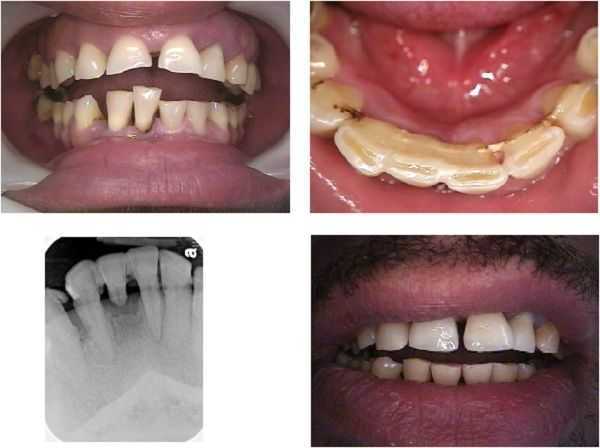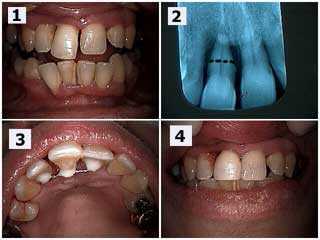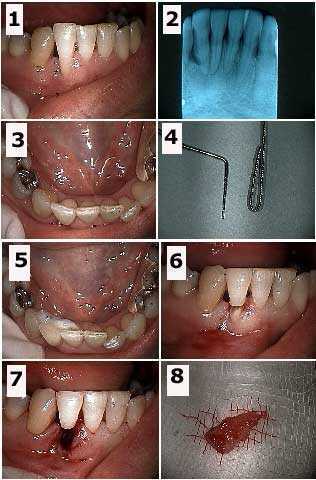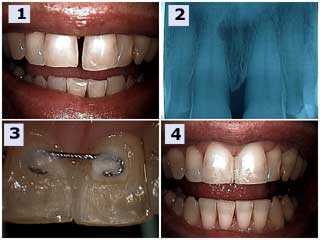Before and after photos on extracoronal and intracoronal teeth splinting performed in our Gum Disease Treatment office.

The lower front tooth had extruded because of severe gum disease. A wire and bonding splint was placed behind these lower front teeth and then the incisal edge of this tooth was reduced to make it level with the adjacent teeth. Then the apical half of this tooth was resected and then extracted, leaving the coronal half intact within the splint (see x-ray). Bonding was then placed interproximally (between the teeth) to hide the wire from a labial view. Lastly, the broken two upper front teeth were bonded.

Pictures show how to place an extracoronal teeth splint. Photo 1) Upper right central incisor (#8) has grown out from the gums resulting in a tooth gap space that has increased over time. 2) Radiograph x-ray shows severe bone loss from periodontal gum disease. This patient wanted to save this tooth for as long as possible. The black dotted line shows the location of a potential root resection if necessary. Root planing was performed after the dental splint was placed. The patient will return in three months to reevaluate periodontal healing with the Periodontist and the potential need for the root resection. 3) Palatal photo of the splint between teeth #’s 7 – 9. 4) Post-op picture taken on the same day. Notice the diastema tooth gap was closed with dental bonding to hide the tooth splint which provides the stabilization and stops the tooth mobility. The incisal edge of #8 was also reduced; this tooth had previously exhibited fremitus.

Extraction of the root of a hopeless tooth #26 and dental splinting the coronal portion to the adjacent teeth in a 40 year-old female. 1) – 3) Initial photos and x-ray before placement of the teeth splint. 4) The wire used for the tooth splint next to a periodontal probe. The wire is doubled to prevent the tooth from rotating around it after placement. 5) This extracoronal splint is bonded to the lingual surfaces of teeth #’s 25 and 27. 6) Initial preparation through the mid-length of the tooth. 7) Following extraction of the tooth root. 8) The extracted tooth root. This patient has already been through two rounds of scaling and root planing. After wound healing of this tooth extraction site she will then have an apically positioned flap periodontal surgery and then possibly a gum graft to build up this area. It is expected that some other method for tooth replacement will be utilized following this periodontal therapy.

Placement of an extracoronal teeth splint on a periodontally involved upper left central incisor tooth #9. 1) & 2) Pre-operative photograph and radiograph. Note the angular bony defect in the x-ray. The patient reported that the tooth was getting longer and that he never previously had the gap space between his two front teeth. 3) Palatal photo of the tooth splint stabilization placed between teeth #’s 8 & 9. 4) Post-operative image one hour later. Teeth bonding was placed to close the gap space and hide the palatal dental splint. The incisal edge of #9 was shortened and the occlusion teeth bite was checked and adjusted for fremitus. Root planing was next performed and the patient placed on a three-month periodontal reevaluation.

Maxillary extracoronal teeth splint stabilization shown in a class 5 periodontal gum disease patient. After scaling and root planing but before open clean out periodontal gum surgery. Tooth #8 needs to be extracted but patient is resistant at this time since many of these teeth are similarly involved. The plan is to reduce the infection and support the patient emotionally with dental splint therapy until he’s ready for more active treatment.